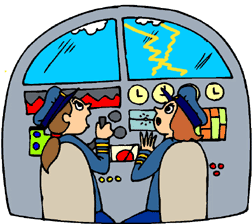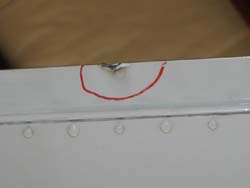Last week while flying back to the Bay Area, the topic for this article came to me in a flash. Well, actually several flashes. Over on the west side of the San Francisco peninsula nature was putting on one of its most dazzling shows. Brilliant bolts of lightning arced across the sky. I didn’t have to look at my Stormscope to know where the bad stuff was. Luckily, I could enjoy this dramatic scene from a safe and respectful distance. The less fortunate were reporting some pretty rough rides to ATC.
The early Vikings believed that lightning came from Thor striking his hammer on an anvil as he rode his chariot across the clouds. There is an alternative belief for the non-Vikings among us that lightning occurs when negative and positive electric charges in the atmosphere start to separate due to the shears associated with thunderstorm development. An accumulation of negative charges in clouds will eventually discharge towards a positive charge such as the earth or other clouds.
 This discharge is basically an electrical spark in which the flash lasts about half-a-second and the heat can be up to five times the temperature of the sun. The noise you hear (thunder) is the compression of the super-heated air around the bolt as it slices through the atmosphere. By the way, lightning strikes occur about 100 times per second on our planet. One study suggested aircraft lightning strikes occur approximately once per every 1000 flight hours.
This discharge is basically an electrical spark in which the flash lasts about half-a-second and the heat can be up to five times the temperature of the sun. The noise you hear (thunder) is the compression of the super-heated air around the bolt as it slices through the atmosphere. By the way, lightning strikes occur about 100 times per second on our planet. One study suggested aircraft lightning strikes occur approximately once per every 1000 flight hours.
The good news is that lightning is a relatively rare factor in fatal aircraft accidents, but it certainly is a potential hazard. Between 1959 and 1988 there were 9 fatal airline accidents attributable to lightning strikes. On December 8, 1963, a Pan American Boeing 707 sustained a lighting strike near Elkton, Maryland, which ignited a fire on the right wing. The wing separated and 81 people were killed. On February 8, 1988, a Metroliner was hit by lightning near Mulheim, Germany, causing the electrical system to fail while IFR. During an uncontrolled descent, a wing broke off resulting in 21 fatalities.
 |
| Lightning strike exit burn on elevator trim tab of a Lear jet |
Normally, when lightning strikes an aircraft, the metal airframe provides a conductive path for the electricity to travel through it and dissipate back into the atmosphere. Composite structures incorporate a metallic mesh to provide the necessary conductive path. Lightning often strikes the front of an aircraft first. The physical evidence of a lightning strike is usually in the form of some small electrical pitting or arcing marks which are often found on nose cones, prop spinners, cowl inlets and leading edges. Similar small burn marks are found where the lightning exits the airframe at control surface trailing edges, trim tabs, and tail cones.
While the external arcing marks are usually a minor cosmetic concern, the energy of a lightning strike can instantly fry electronic equipment causing the pilot to lose instrumentation and avionics, which is a bad thing to happen when traversing a thunderstorm under IFR conditions. I know of one pilot flying a Cessna 210 who had this happen and he lost control of the aircraft. He barely recovered in time. I have also seen radar dishes look like black cast-iron frying pans after a lightning strike.
Besides the electronics, another concern about a bolt of lighting traveling through an aircraft is the destructive potential to bearing surfaces. Bearing surfaces are typically designed for applications where frictional contact is to be kept to a minimum. A lightning strike may cause electrical pitting on these bearing surfaces essentially destroying them. A strike on other surfaces such as propeller blades may compromise structural integrity requiring a complete replacement depending on the manufacture’s criteria. Usually manufacturers provide lightning strike inspection procedures for their airplanes and components.
 Under the worst circumstances, a lightning strike can penetrate the fuel system and ignite fuel vapors causing an aircraft to explode or burn as in the case of the earlier mentioned 707 accident. I investigated an accident involving a Piper Arrow that did ignite and explode in the air while traveling through convective activity. Due to the extensive destruction of the plane we could not conclusively state that lightning caused the explosion, but it seemed a logical possibility given the surrounding circumstances. Most planes are designed to prevent this situation, but a mechanical or structural deficiency could allow it to happen.
Under the worst circumstances, a lightning strike can penetrate the fuel system and ignite fuel vapors causing an aircraft to explode or burn as in the case of the earlier mentioned 707 accident. I investigated an accident involving a Piper Arrow that did ignite and explode in the air while traveling through convective activity. Due to the extensive destruction of the plane we could not conclusively state that lightning caused the explosion, but it seemed a logical possibility given the surrounding circumstances. Most planes are designed to prevent this situation, but a mechanical or structural deficiency could allow it to happen.
 Consider that lightning is really just an unusually bright “No Trespassing” sign for aviators. You can often see and avoid it way in advance if you are VFR and, if IFR, it is easily detected if you have a Stormscope or Strikefinder on board. Lightning is trying to tell you that this is a place where you are not welcome. With in its boundaries you will meet the rest of the family: hail, heavy rain showers, and killer turbulence. Lightning won’t be a problem if you know enough to stay away from thunderstorms. If you don’t know enough to stay away from thunderstorms, than kindly put your pilot’s license back in the cereal box from where it came from. Enjoy the fireworks, but do it from a safe distance.
Consider that lightning is really just an unusually bright “No Trespassing” sign for aviators. You can often see and avoid it way in advance if you are VFR and, if IFR, it is easily detected if you have a Stormscope or Strikefinder on board. Lightning is trying to tell you that this is a place where you are not welcome. With in its boundaries you will meet the rest of the family: hail, heavy rain showers, and killer turbulence. Lightning won’t be a problem if you know enough to stay away from thunderstorms. If you don’t know enough to stay away from thunderstorms, than kindly put your pilot’s license back in the cereal box from where it came from. Enjoy the fireworks, but do it from a safe distance.
Editor’s Note: This article was written by Ken Steiner prior to his retirement from the United States Aircraft Insurance Group as a Vice-President and Claims Manager. During his career, Ken investigated thousands of aircraft accidents involving small planes, crop dusters, helicopters, corporate aircraft, and airliners. He has been on-site at over 100 fatal aircraft accident investigations. He is currently an Aviation Investigative Consultant and is also a Pilot and Tactical Flight Officer for the San Mateo County Sheriff’s Air Support Unit. He owns a Cessna 182 based at San Carlos and holds ATP and CFI certificates with over 5000 flying hours.


